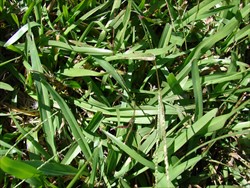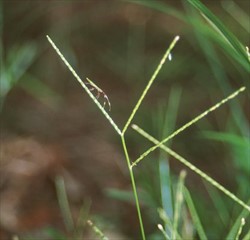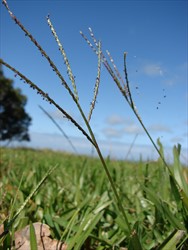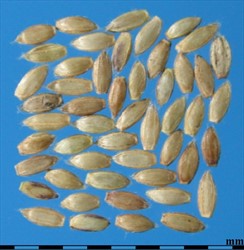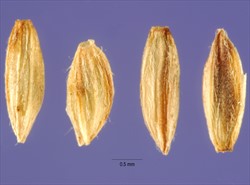Tropical Forages
Axonopus fissifolius (Raddi) Kuhlm.
Basionym: Paspalum fissifolium Raddi; Axonopus affinis Chase
Family: Poaceae (alt. Gramineae) subfamily: Panicoideae tribe: Paspaleae subtribe: Paspalinae.
Shallow-rooted (>90% of roots in the 0‒5 cm layer) perennial, initially forming shortly rhizomatous tufts that quickly develop vigorous stolons with relatively short, glabrous oval-section (± 2 × 1.5 mm) internodes; forms a dense mat with foliage 15‒30 cm tall, and flowering culms mostly 30‒60 cm; can be mowed to a turf. Leaf sheath compressed, keeled, largely glabrous; ligule a fringed membrane 0.5 mm long; blades 4‒6 (‒8) mm wide, and 5‒15 (‒28) cm long, flat or folded, glabrous except for sparse spreading hairs on the lower margins of young leaves, bluntly acute at the tip. Inflorescence a panicle comprising 2 or 3 (rarely 4‒7) slender, spikelike racemes, paired or sub-digitately arranged on a long slender peduncle; racemes (2‒) 3‒7 (‒10) cm long; spikelets 1.7‒2.8 mm long, 1 mm broad, inserted alternately at either side of a flattened rachis; caryopsis tan to pale brown, compressed-ellipsoid to lenticular, 1.4‒1.8 mm long. 2.5‒3 million seeds per kg.
Similar species
Differs from A. compressus in having more slender culms and stolons, narrower leaves and shorter, more obtuse spikelets; culm nodes are glabrous (bearded in A. compressus).
Asia: 类地毯草 lei di tan cao (China); rumput permaidani (Malaysia)
English: caratao grass, carpet grass, common carpet grass, Louisiana grass (USA); mat grass, narrow-leaved (narrowleaf) carpet grass, Durrington grass (Australia)
Europe: Teppichrasengras (German); assonopo (Italian)
Latin America: grama-missioneira (Brazil); gramalote (Spanish); zacate amargo (Mexico)
Native:
Northern America: Mexico (s.), USA (Alabama, Arkansas, Florida, Georgia, Louisiana, Mississippi, North Carolina, Oklahoma (s.e.), South Carolina, Texas
Caribbean: Grenada
Central America: Belize, Costa Rica, El Salvador, Guatemala, Honduras, Nicaragua, Panama
South America: Argentina, Bolivia, Brazil, Colombia, Guyana, Paraguay, Uruguay, Venezuela
Cultivated/naturalized:
Widely naturalized and used as a turf and forage in the humid tropics and subtropics in Africa, Asia, Australia and the Pacific Islands
Forage
Used as a permanent pasture in moist, low fertility soils. It is generally too low growing to be useful in cut-and-carry systems or for fodder conservation.
Environment
Dense ground cover for erosion control and turf in moist, low fertility soils.
Occurs on low, flat areas in humid and sub-humid warm temperate to tropical woodland and savannah.
Soil requirements
Best growth on light-textured, moist soils with pH 5‒6 (4.3‒7.0), flourishing in soils too infertile for Paspalum dilatatum, but also adapted to clays, mucks and peats.
Moisture
Mostly found in areas with an annual rainfall of 750 mm up to 4,000 mm. Drought tolerance is low but higher than in A. compressus. While preferring moist soils, it is not well adapted to prolonged flooding or swampy conditions.
Temperature
Latitudinal range of distribution: 40° N to 40° S. Mean annual temperature range reported: 8‒30 °C. Flowering inhibited at temperatures <13 °C. Some frost tolerance (higher than A. compressus).
Light
Best growth on long days (15 h). Moderately shade-tolerant, but less so than A. compressus.
Reproductive development
A. fissifolius flowers over a wide range of daylengths, seed production being greatest at 12‒14 h daylength.
Defoliation
Thrives under heavy grazing, down to stubble height of 5‒5.7 cm. Frequent grazing also helps to maintain it in a vegetative state.
Fire
Although mostly growing in areas where fire is not a problem, it recovers quickly from fire.
Guidelines for establishment and management of sown forages.
Establishment
When seed is available, it is broadcast onto, or shallowly sown into, a well-prepared seedbed or ashes after a scrub burn. Subsequent rolling helps maintain soil moisture and ensures close contact between soil and seed. Choice of sowing rate depends on quality of seedbed and the rate of ground cover required; 5‒15 kg/ha are recommended.
Fertilizer
Adapted to low-fertility soils but will respond to fertilizers, particularly nitrogen, however, with low use efficiency.
Compatibility (with other species)
Dominates annual weeds in forages. As soil nitrogen levels decline, because of its low-fertility requirements A. fissifolius can successfully invade pastures of more fertility demanding species such as Paspalum dilatatum and Cynodon dactylon.
Companion species
Grasses: Axonopus compressus, Chrysopogon aciculatus.
Legumes: Arachis pintoi, Grona heterophylla, G. triflora, Lotus uliginosus, Trifolium repens, , Vigna parkeri.
Pests and diseases
Although a range of fungi and nematodes have been found on A. fissifolius, biotic constraints are not considered to be a production-limiting factor.
Ability to spread
Under favourable conditions and being a prolific seeder, spreads by seeds (more so than A. compressus) and by stolons and rhizomes (less so than A. compressus).
Weed potential
It can become a troublesome weed in the wet tropics.
Nutritive value
Much lower than e.g. Paspalum dilatatum. Reported CP of fresh grass: 7.0%, dropping after seeding to 4‒6%; data from south Brazil: 10.3% CP after 6 weeks, 6.3% after 20 weeks. In vivo organic matter digestibility of fresh grass: 66.0%.
Palatability/acceptability
Fairly palatable in vegetative state. Usually well-grazed in association with companion legume.
Toxicity
No record of toxicity.
Feedipedia link
Dry matter
DM yields are low in comparison with other pasture grasses; mostly in the range of 1‒5 t/ha/yr, even in fertilised grass.
Animal production
Live-weight gains recorded on unfertilised A. fissifolius are very low (70‒170 kg/ha).
2n = 20, 40, 60, 80.
Commercial seed is largely produced in the humid sub-tropics, mostly as 'opportunity' crops. While in most other grass seed crops, stands are 'cleared off' to produce a synchronous crop, and nitrogen fertilizer applied to promote tillering, this is generally not followed for seed crops of this species. Crops ripen unevenly and are mostly harvested non-destructively, providing about 50 kg/ha of seed per pass. Fresh seed should be dried at no more than 35 ºC, to avoid damage to the seed.
Susceptible to DSMA, bentazon, bromoxynil, 2,2-DPA and metsulfuron methyl. Tolerant of diclofop methyl.
- Grows on poor soil.
- Good ground cover.
- Tolerates heavy grazing.
- Does not compete strongly with companion legume.
- Poor drought tolerance.
- Very low nutritive value.
- Low dry matter yield.
- Short growing season.
Bogdan, A.V. (1977) Tropical Pasture and Fodder Plants. Longman Inc., New York, USA. p. 44–45.
Campbell, L.R.V. (1999) Paspalum dilatatum and Axonopus affinis in Australia. In: Loch, D.S. and Ferguson, J.E. (eds) Forage seed production, Volume 2: Tropical and subtropical species. CABI Publishing, Wallingford, Oxon, UK. p. 325–333.
Cassidy, G.J. (1971) Response of a mat grass - paspalum sward to fertilizer application. Tropical Grasslands 5:11–22. bit.ly/39heQdj
Evans, D.O., Joy, R.J. and Chia, C.L. (1988) Cover Crops for Orchards in Hawaii. University of Hawaii at Manoa, Honolulu, Hawaii, USA. hdl.handle.net/10125/5989
Jones, R.M. and Bunch, G.A. (2003) Experiences with farm pastures at the former CSIRO Samford Research Station, south-east Queensland, and how these relate to results from 40 years of research. Tropical Grasslands 37:151–164. bit.ly/2ws2wt2
Lima, L.M.S., Alquini, Y., Brito, C.J.F.A. de and Deschamps, F.C. (2001) Degradação ruminal dos tecidos vegetais e composição bromatológica de cultivares de Axonopus scoparius (Flüegge) Kuhlm. e Axonopus fissifolius (Raddi) Kuhlm. Ciência Rural 31:509–515. doi.org/10.1590/S0103-84782001000300025
None released.
None reported.
